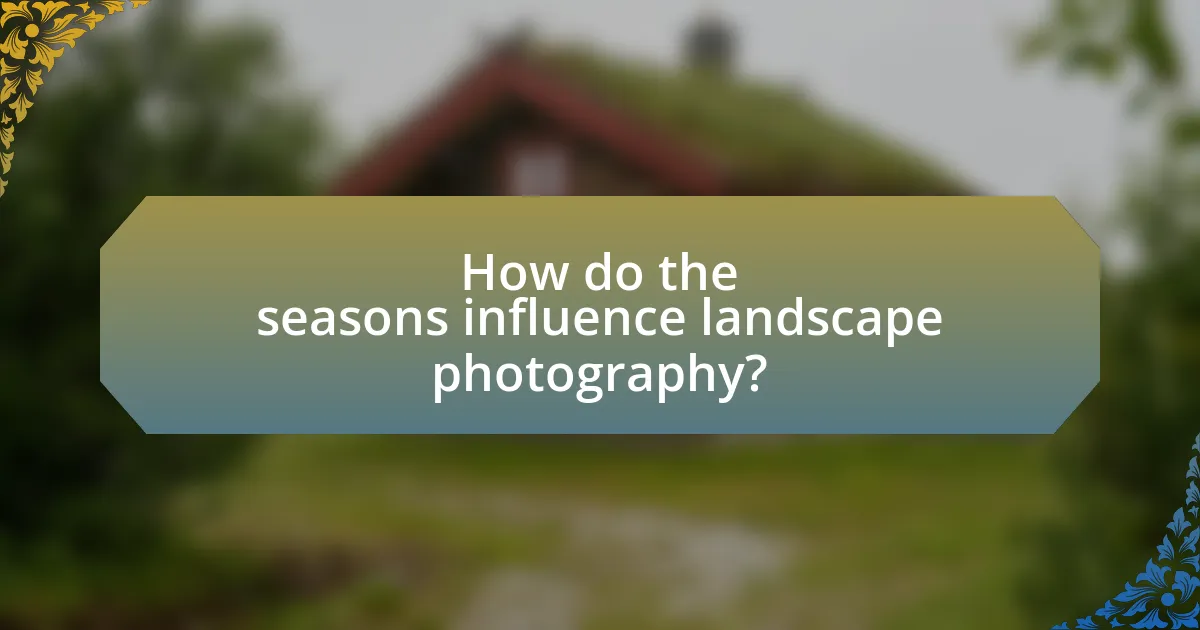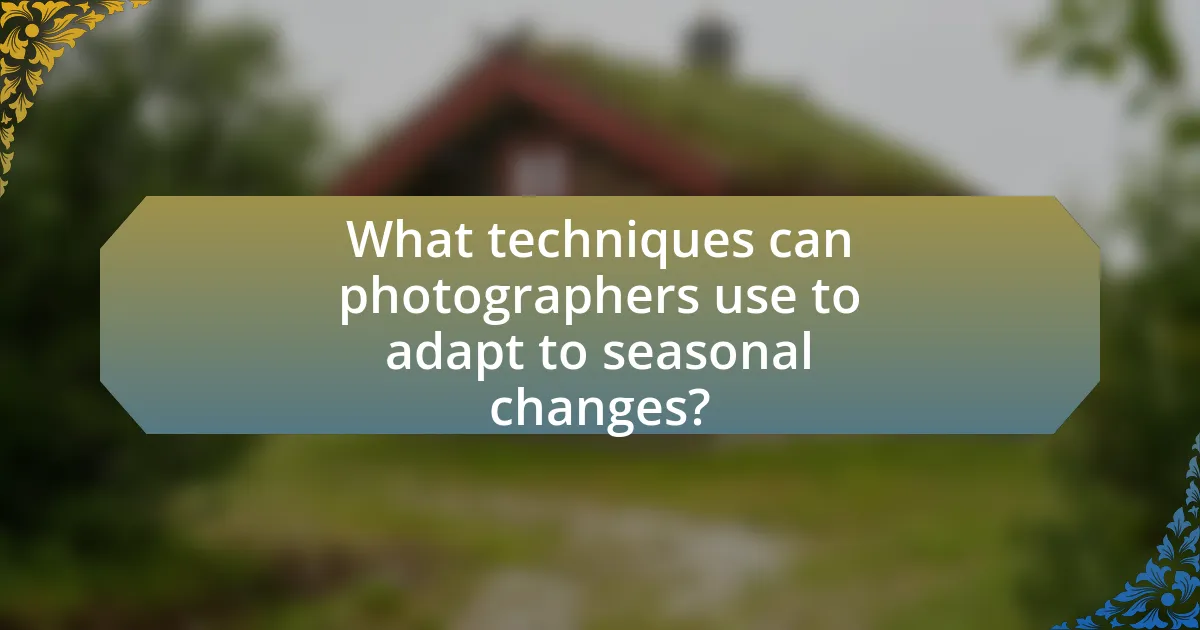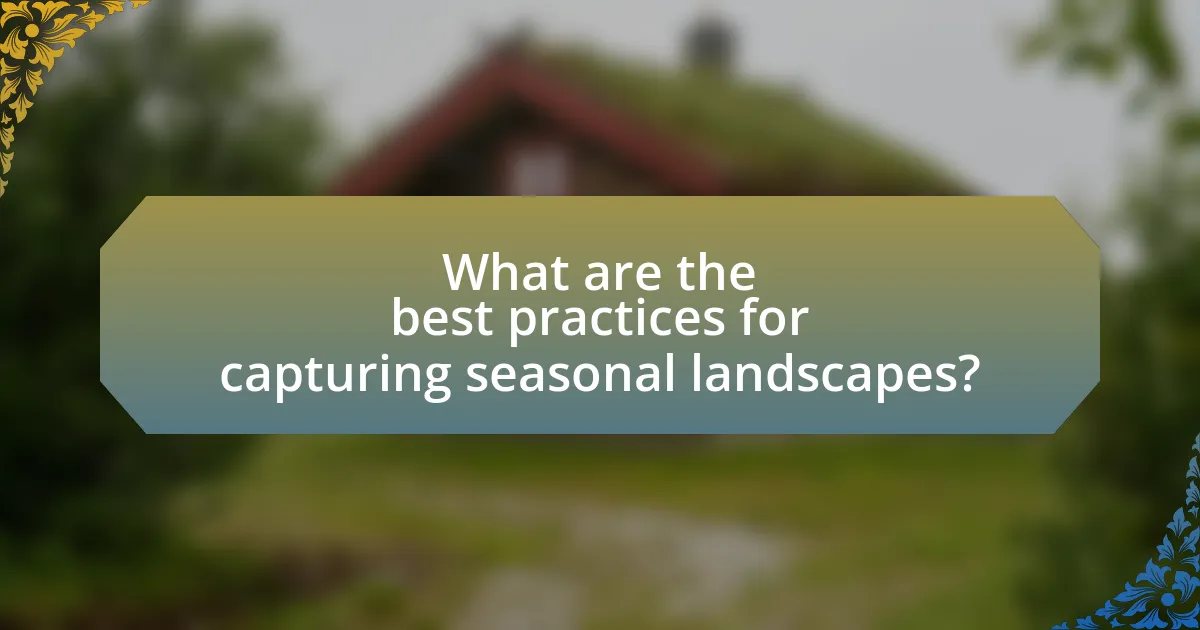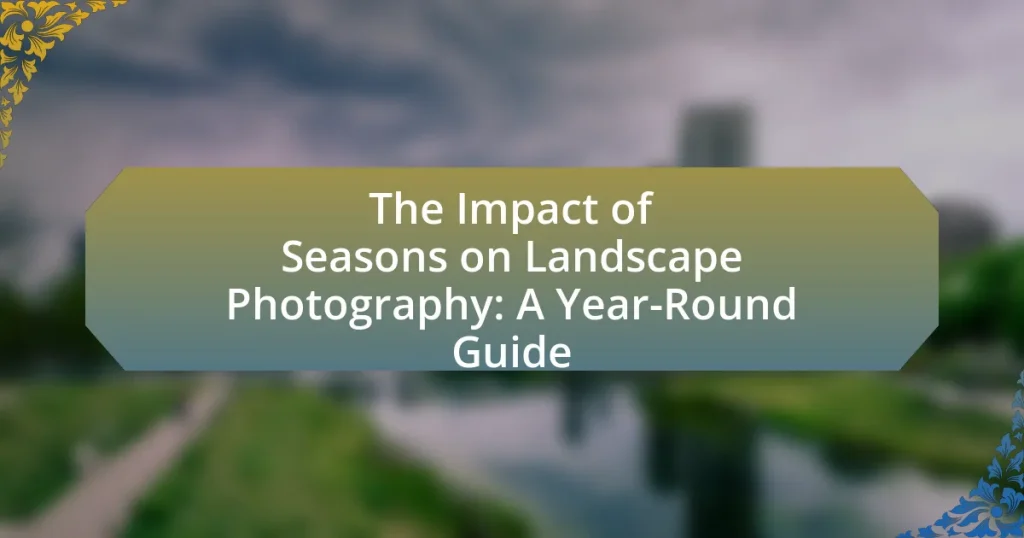The article focuses on the impact of seasons on landscape photography, providing a comprehensive guide for photographers throughout the year. It examines how each season—spring, summer, autumn, and winter—affects colors, lighting, and mood, influencing composition and subject selection. Key characteristics of each season are outlined, along with the importance of understanding seasonal changes for capturing compelling images. The article also discusses practical techniques for adapting to seasonal conditions, including gear adjustments, planning shoots around light changes, and effective post-processing methods to enhance seasonal elements in photographs.

How do the seasons influence landscape photography?
Seasons significantly influence landscape photography by altering the colors, lighting, and overall mood of the environment. In spring, vibrant blooms and fresh greenery create lively compositions, while summer offers bright, harsh light that can enhance textures and contrasts. Autumn introduces warm hues of red, orange, and yellow, providing dramatic backdrops, and winter presents a stark, minimalist aesthetic with snow and ice that can evoke a sense of tranquility. These seasonal changes not only affect the visual elements but also dictate the best times for capturing specific landscapes, as different weather conditions and natural phenomena, such as fog or snow, can enhance the photographic experience.
What are the unique characteristics of each season in landscape photography?
Spring in landscape photography is characterized by vibrant colors and blooming flora, which create dynamic compositions. The increased daylight and softer sunlight enhance the overall brightness and saturation of images. Summer features lush greenery and longer days, allowing for extended shooting hours, while the intense sunlight can create harsh shadows and high contrast. Autumn is marked by a stunning array of warm hues as leaves change color, providing rich textures and dramatic landscapes, often enhanced by misty mornings. Winter presents a stark, minimalist aesthetic with snow-covered scenes, offering unique lighting conditions and opportunities for capturing reflections and contrasts in a serene environment. Each season provides distinct visual elements that influence composition, color palette, and mood in landscape photography.
How does winter affect lighting and color in landscape photography?
Winter significantly alters lighting and color in landscape photography by introducing unique atmospheric conditions and a distinct color palette. The low angle of the sun during winter creates softer, diffused light, which enhances shadows and adds depth to images. Additionally, the presence of snow can reflect light, resulting in brighter scenes and a cooler color temperature, often shifting hues towards blue and gray. This seasonal change can lead to striking contrasts between the white snow and the darker elements of the landscape, such as trees and rocks, thereby enriching the visual composition.
What elements of spring enhance landscape photography opportunities?
Spring enhances landscape photography opportunities through vibrant colors, blooming flora, and dynamic weather conditions. The emergence of flowers and fresh greenery creates a rich palette that attracts photographers seeking to capture the essence of renewal. Additionally, spring often brings varied weather patterns, including dramatic skies and soft lighting, which can add depth and mood to photographs. Studies show that the increased daylight hours during spring also provide more opportunities for golden hour photography, enhancing the overall quality of images captured during this season.
How does summer provide different photographic challenges and advantages?
Summer presents unique photographic challenges and advantages primarily due to its intense lighting conditions and vibrant natural scenery. The bright sunlight during summer can create harsh shadows and overexposed highlights, making it difficult to capture balanced images. However, this same sunlight enhances colors, resulting in vivid landscapes and lush greenery that can elevate the visual appeal of photographs. Additionally, summer often provides longer daylight hours, allowing photographers more time to capture the perfect shot. The abundance of outdoor activities and events during this season also offers diverse subjects for photography, from festivals to wildlife.
What autumn features are most appealing for landscape photographers?
Autumn features that are most appealing for landscape photographers include vibrant foliage, dramatic lighting, and atmospheric conditions. The changing colors of leaves, ranging from deep reds to bright yellows, create stunning contrasts against blue skies or gray clouds, enhancing the visual impact of photographs. Additionally, the low angle of sunlight during autumn produces long shadows and golden hour effects, which add depth and warmth to images. Atmospheric conditions such as mist and fog can create a sense of mystery and mood, further enriching the landscape. These elements collectively contribute to the unique aesthetic qualities that make autumn a favored season for landscape photography.
Why is understanding seasonal changes important for landscape photographers?
Understanding seasonal changes is crucial for landscape photographers because it directly influences the quality of light, color palettes, and overall composition of their images. Each season offers unique lighting conditions; for instance, golden hour during autumn enhances warm tones, while spring brings vibrant greens and blooming flowers. Additionally, seasonal weather patterns affect accessibility to locations and the presence of elements like snow or fog, which can dramatically alter a scene’s mood. Photographers who adapt their techniques and planning according to these seasonal variations can capture more compelling and visually striking landscapes, ultimately improving their portfolio and artistic expression.
How can seasonal knowledge improve composition and subject selection?
Seasonal knowledge enhances composition and subject selection by allowing photographers to align their work with the unique characteristics of each season. For instance, spring offers vibrant colors and blooming flowers, which can be used to create dynamic compositions, while autumn provides rich, warm tones and dramatic foliage that can enhance visual storytelling. Research indicates that understanding seasonal changes can lead to more effective use of natural light and atmospheric conditions, improving overall image quality. For example, winter’s low sun angle can create long shadows and interesting textures in snow, while summer’s lush landscapes can provide a backdrop for vibrant subjects. This strategic approach to timing and subject matter ultimately results in more compelling and contextually relevant photographs.
What role does weather play in seasonal landscape photography?
Weather significantly influences seasonal landscape photography by affecting lighting, mood, and the overall aesthetic of the scene. For instance, clear skies during autumn can enhance the vibrant colors of foliage, while overcast conditions can create a soft, diffused light that is ideal for capturing the subtle tones of winter landscapes. Additionally, weather phenomena such as fog or rain can add depth and drama to photographs, making them more visually compelling. Studies show that photographers often seek specific weather conditions to evoke particular emotions or themes in their work, demonstrating the critical role weather plays in shaping the final image.

What techniques can photographers use to adapt to seasonal changes?
Photographers can adapt to seasonal changes by adjusting their shooting techniques, equipment, and planning strategies. For instance, they can utilize different camera settings to accommodate varying light conditions, such as using a higher ISO during winter months when light is scarce. Additionally, photographers can change their composition techniques to highlight seasonal elements, like capturing vibrant autumn foliage or the starkness of winter landscapes.
Planning is crucial; photographers should research seasonal weather patterns and optimal times for shooting specific locations, which can enhance the quality of their images. For example, the golden hour varies with seasons, and knowing the exact timing can significantly improve the aesthetic of the photographs.
Moreover, using filters, such as polarizers or ND filters, can help manage reflections and exposure, especially in bright summer conditions or during snow. These techniques collectively enable photographers to effectively capture the essence of each season, ensuring their work remains dynamic and engaging throughout the year.
How can photographers prepare for seasonal shifts in landscape photography?
Photographers can prepare for seasonal shifts in landscape photography by researching seasonal weather patterns and planning shoots accordingly. Understanding how light changes with the seasons allows photographers to capture optimal conditions, such as golden hour during autumn or vibrant colors in spring. Additionally, photographers should update their gear to accommodate different weather conditions, such as waterproof equipment for rainy seasons or filters to manage glare in summer. Historical data shows that certain locations exhibit peak photographic potential during specific seasons, reinforcing the need for strategic planning. For instance, the fall foliage in New England attracts photographers annually, highlighting the importance of timing in landscape photography.
What gear adjustments are necessary for different seasons?
For different seasons, gear adjustments in landscape photography include changing lenses, filters, and protective equipment. In spring, a wide-angle lens captures blooming landscapes, while polarizing filters enhance colors and reduce glare. In summer, lightweight tripods are essential for portability, and UV filters protect against harsh sunlight. Autumn requires a telephoto lens to capture distant foliage, and neutral density filters help manage exposure during bright days. In winter, weather-sealed gear is crucial to withstand snow and moisture, and a sturdy tripod is necessary for stability on icy surfaces. These adjustments optimize image quality and ensure equipment durability across varying seasonal conditions.
How can photographers plan their shoots around seasonal light changes?
Photographers can plan their shoots around seasonal light changes by utilizing tools such as light meters, smartphone apps, and online resources that provide sunrise and sunset times, as well as the angle of sunlight throughout the year. These tools allow photographers to determine the best times for capturing optimal lighting conditions, which vary significantly with the seasons. For instance, during winter, the sun is lower in the sky, resulting in longer shadows and softer light, while summer offers higher sun angles and shorter shadows. By understanding these variations, photographers can schedule their shoots to coincide with the golden hour—shortly after sunrise or before sunset—when the light is most flattering. Additionally, tracking seasonal changes in foliage and weather patterns can enhance the composition and mood of landscape photographs, making it essential for photographers to stay informed about their local environment.
What post-processing techniques are effective for seasonal landscape photos?
Effective post-processing techniques for seasonal landscape photos include color correction, contrast adjustment, and selective sharpening. Color correction enhances the vibrancy of seasonal hues, such as the warm tones of autumn or the cool tones of winter, ensuring that the image accurately reflects the season’s mood. Contrast adjustment helps to define the depth and texture of the landscape, making elements like clouds or foliage stand out more prominently. Selective sharpening can be applied to specific areas, such as the foreground or focal points, to draw attention and enhance detail without affecting the entire image. These techniques are widely used by photographers to create visually compelling seasonal landscapes that resonate with viewers.
How can color grading enhance seasonal characteristics in photos?
Color grading can enhance seasonal characteristics in photos by adjusting hues, saturation, and contrast to reflect the mood and atmosphere of each season. For instance, warmer tones can evoke the feeling of summer or autumn, while cooler tones can represent winter or spring. This technique allows photographers to emphasize specific elements, such as the vibrant colors of fall foliage or the muted tones of a snowy landscape, thereby creating a more immersive experience for the viewer. Studies in visual perception indicate that color influences emotional responses, supporting the effectiveness of color grading in conveying seasonal themes.
What editing tools are best for emphasizing seasonal elements?
The best editing tools for emphasizing seasonal elements in landscape photography include Adobe Lightroom, Adobe Photoshop, and Capture One. Adobe Lightroom allows for precise adjustments in color temperature and saturation, which can enhance the vibrancy of seasonal hues, such as the warm tones of autumn or the cool tones of winter. Adobe Photoshop offers advanced layering and masking techniques, enabling photographers to selectively highlight seasonal features like blooming flowers in spring or snow-covered landscapes in winter. Capture One provides robust color grading options that can effectively accentuate seasonal changes in foliage and lighting. These tools are widely recognized in the photography community for their effectiveness in enhancing seasonal characteristics, as evidenced by their popularity among professional photographers.

What are the best practices for capturing seasonal landscapes?
The best practices for capturing seasonal landscapes include planning your shoots according to the specific characteristics of each season, utilizing the right equipment, and being mindful of lighting conditions. For instance, in spring, vibrant colors and blooming flowers can be highlighted by shooting during the golden hour, while autumn landscapes benefit from capturing the rich hues of foliage. Using a tripod ensures stability for long exposures, especially in winter when light is limited. Additionally, understanding the seasonal weather patterns can help photographers anticipate the best conditions for capturing dramatic skies or reflections in water. These practices enhance the quality and impact of seasonal landscape photography.
How can photographers maximize their creativity throughout the year?
Photographers can maximize their creativity throughout the year by actively engaging with seasonal changes and exploring diverse environments. Each season offers unique lighting, colors, and subjects that can inspire new perspectives and techniques. For instance, spring provides vibrant blooms, summer offers lush landscapes, autumn showcases rich foliage, and winter presents stark contrasts and textures. By planning shoots around these seasonal characteristics, photographers can capture a wide range of visual narratives. Additionally, participating in photography challenges or workshops can stimulate creativity by encouraging experimentation and collaboration with other photographers.
What tips can help photographers find unique seasonal perspectives?
Photographers can find unique seasonal perspectives by exploring diverse locations at different times of the year, utilizing natural light variations, and focusing on seasonal elements like foliage or weather conditions. For instance, visiting the same landscape during spring and autumn can reveal contrasting colors and textures, enhancing visual storytelling. Additionally, the angle and quality of light change with the seasons; for example, golden hour in winter can create dramatic shadows and highlights. Research indicates that seasonal changes significantly affect the mood and composition of photographs, making it essential for photographers to adapt their techniques accordingly.
How can photographers stay motivated during less favorable seasons?
Photographers can stay motivated during less favorable seasons by setting specific goals, exploring new techniques, and engaging in personal projects. Setting goals helps maintain focus and provides a sense of direction, while exploring new techniques can reignite creativity and enhance skills. Engaging in personal projects allows photographers to experiment without the pressure of client expectations. Research indicates that creative individuals often find motivation through self-directed projects, which can lead to increased satisfaction and improved skills (Amabile, T. M. (1996). Creativity in Context. Westview Press).
What common mistakes should photographers avoid in seasonal landscape photography?
Photographers should avoid several common mistakes in seasonal landscape photography, including neglecting to plan for changing light conditions, failing to consider seasonal weather variations, and overlooking the importance of composition. Planning for changing light conditions is crucial, as the quality and angle of light can vary significantly with the seasons; for instance, golden hour in winter may occur at different times than in summer. Seasonal weather variations can affect accessibility and visibility, so photographers must check forecasts and be prepared for sudden changes. Additionally, composition should not be compromised; seasonal elements like foliage or snow can enhance a scene, but poor framing can detract from the overall impact. By addressing these mistakes, photographers can significantly improve their seasonal landscape photography outcomes.
How can overexposure or underexposure affect seasonal images?
Overexposure can wash out colors and details in seasonal images, while underexposure can lead to loss of detail in shadows and dark areas. In seasonal photography, overexposure often results in bright highlights that obscure the vibrancy of autumn foliage or the subtle tones of winter landscapes, making them appear flat and lifeless. Conversely, underexposure can create overly dark images that fail to capture the essence of spring blooms or summer skies, resulting in a lack of visual interest and depth. Accurate exposure is crucial for conveying the unique characteristics of each season, as it directly influences the viewer’s perception and emotional response to the image.
What are the pitfalls of not adapting to seasonal conditions?
Not adapting to seasonal conditions in landscape photography can lead to missed opportunities for capturing optimal images. Photographers who ignore seasonal changes may find their work lacks variety and fails to showcase the unique beauty that each season offers, such as vibrant autumn foliage or serene winter landscapes. Additionally, not adjusting techniques and equipment to suit different weather conditions can result in poor image quality; for instance, shooting in harsh midday sunlight without considering the softer light of golden hour can lead to overexposed images. Furthermore, failing to adapt can limit a photographer’s ability to connect with their audience, as viewers often seek seasonal imagery that resonates with their experiences and emotions.
What practical tips can enhance seasonal landscape photography experiences?
To enhance seasonal landscape photography experiences, photographers should focus on timing, equipment, and composition. Timing is crucial; for instance, shooting during the golden hour—shortly after sunrise or before sunset—provides optimal lighting conditions that enhance colors and textures in landscapes. Equipment should be tailored to the season; using polarizing filters can reduce glare and enhance colors in summer, while a sturdy tripod is essential for stability in winter conditions. Composition techniques, such as leading lines and the rule of thirds, help create visually appealing images regardless of the season. These strategies are supported by the fact that many professional photographers emphasize the importance of light and composition in their work, as seen in resources like “The Photographer’s Eye” by Michael Freeman, which discusses effective composition techniques.















